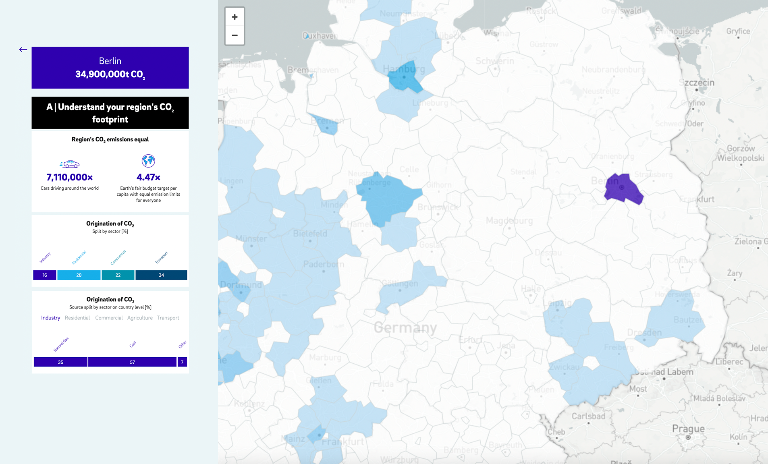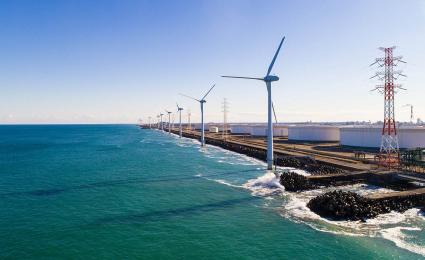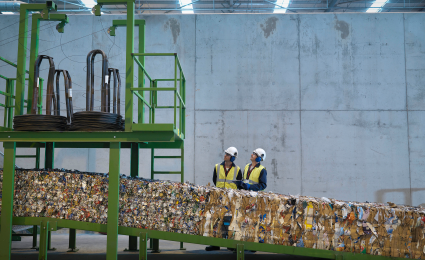Access to green energy becomes a major factor when selecting production facilities as part of global value chains. Countries need to offer renewable energy infrastructures.


Combating climate change – Now means NOW!
Short-term local action with the RB Carbon Footprint Model
Faced with the undeniable urgency of climate change, there is no question about the need for rapid action to curb carbon emissions. As achieving short-term impacts becomes vital to prevent a further rise in temperatures and buy time for long-range targets, the RB Carbon Footprint Model helps foster climate action at the local level. Assuming, of course, that we are serious about taking action now…

"The time has come to move from prediction to action as we approach the threshold of a 1.5°C increase in global temperatures."
From prediction to action
With the world approaching the threshold of a 1.5°C increase in global average temperatures, the time has come to move from prediction to action. Aware that they must slash greenhouse gas emissions by an average proportional target of 55% (compared to 2018), most countries have so far focused on longer-term "big hits".
To rise to the challenge, proportional targets relative to the status quo are a good place to start. But fair targets are also needed to equitably assign absolute CO2 emission budgets to each person on the planet. Net zero targets must then cancel out additional net CO2 emissions through focused offsetting measures. Lastly, zero emission targets must strive to eliminate emissions in the first place.
Using the fair target approach, an average carbon budget of 2.2 t CO2 per capita worldwide can be calculated. However, Western nations such as France (5.2 t), Germany (9.5 t) and the USA (16.6 t) have a lot of work to do to bring down their carbon output.
These imbalances must be tackled quickly and resolutely. But how?
What can we do?
Technological step changes target really big wins (in green hydrogen and CCS, for instance), but these are still far from market readiness and will require heavy investment/subsidies in the long term. Systemic changes – such as electrification of heating and mobility and the transition to renewables – are within closer reach but will demand substantial alterations to infrastructure, energy assets and, frequently, legislation. For fast action, then, we are left with energy efficiency solutions , which can be put into effect immediately on a local (and even individual) level using technologies that exist today. This is where the RB Carbon Footprint Model comes in.
The RB Carbon Footprint Model enables effective local action now
The RB Carbon Footprint Model empowers decision-makers to immediately start making a difference to climate change at the local level by:
- Identifying the amount and sources of carbon emissions in their locality
- Quantifying the impact of each solution and benchmarking it against defined climate targets
- Accessing a broad array of solutions that can reduce emissions now in every sector
Model methodology
The RB Carbon Footprint Model quantifies the CO2 reduction impact of measures at the level of individual zip codes for each city or district in a country. Combining CO2 data published at citycarbonfootprints.info with structural data on a local level, it calculates the emissions generated by sector of industry and by energy use in each zip code area.
Available and profitable solutions documented by the Solar Impulse Foundation (SIF) are then applied in a top-down approach to the resultant CO2 footprint reduction per zip code, e.g. by adding in employment and population data.
The RB Carbon Footprint Model focuses on CO2 as the single most important greenhouse gas and assumes a notional adoption rate of 75% for the solutions it proposes. Realistic potential for the swift reduction of CO2 emissions can thus be quantified on a local level – empowering public and private stakeholders to take resolute action to mitigate climate change and, where necessary, adapt to its consequences.
Over the last four years, the non-profit Solar Impulse Foundation (SIF) has identified more than 1,000 solutions that can protect the environment in a profitable way, awarding them the Solar Impulse Efficient Solutions Label. Assessed by an international network of subject matter experts coordinated by SIF, this unique evaluation process serves to identify solutions that are credible and impactful. Roland Berger has thus far used a subset of 200 of these solutions to develop the RB Carbon Footprint Model and to quantify their emission reduction potential for various countries.
Based on the model output, the results of applying these solutions to four European focus countries – France, Germany, Italy and Scotland – outline the path to a green future. As the figure below shows, these short-term measures alone put France, for instance, virtually on course to meet its share of the 1.5°C target. With the impact of the solutions as calculated by the model, all four countries can indeed identify a reduction potential above the 25% target of 2°C.
Beyond the short term
Merely getting on the pathway to the 1.5°C target is not enough, however, so longer-term systemic changes and technological step changes must obviously be pursued with equal vigor. That said, the "quick wins" make a valuable and necessary contribution, laying the basis for further structural changes going forward. Considering the results of the RB Carbon Footprint Model on a per capita basis, short-term solutions for Germany alone could realize a reduction from 9.5 to 5.5 tons per capita. Even from that point, though, emissions must be significantly cut to reach the country's fair per capita budget.
The RB Carbon Footprint Model shows that measurable local action is manifestly viable. Short-term solutions are effective, can be applied without delay and bring us closer to our climate targets. What, then, are we still waiting for?
Register below to download the full study "Combating climate change - now means NOW!" and learn more about how you can effectively and immediately combat climate change locally.
Register now to download the publication to learn more about the concrete steps, which can be taken now to combat climate change and get regular insights into sustainability topics.


![Infographic: Solution reduction potential by country [CO2 p.a. in million tons]](https://img.rolandberger.com/content_assets/content_images/captions/roland_berger_art412_carbon_footprint_model_gt01_image_caption_none.jpg?v=770441)
![Reduction achievements by country [CO2 p.a. per capita tons]](https://img.rolandberger.com/content_assets/content_images/captions/roland_berger_art412_carbon_footprint_model_gt02_image_caption_none.jpg?v=770441)



